Aviation assistance in disaster relief is crucial. When that disaster affects an island, it becomes critical.
After Hurricane Dorian hit the Bahamas in September 2019, aviation responded at a level never seen before. But it was a chaotic, dangerous mess.
Nothing about responding to a disaster is easy. Those that choose to get involved in relief efforts, and dedicate their weeks, months, and years to assist others in times of their greatest need, know the kaleidoscope of challenges all too well. The flow of relief will never be smooth and well-oiled.
But for all the flaws and cracks in relief operations, the “Bahamas Airlift” of 2019 showed us the ones that belong to aviation in glaring clarity. In this report, we highlight the primary problems. This is based on a survey we carried out in January 2020. A total of 254 aircraft operators, relief organizations, and individual pilots responded.
1. It’s the Wild West out there

The problem: Saturated airspace, no ATC
“Wild West” was the term repeatedly used by pilots to describe what it was like flying in the northern islands in the first days after Dorian. The four main airports that saw relief operations in the affected areas were Freeport (MYGF), Treasure Cay (MYAT), Sandy Point (MYAS) and Marsh Harbor (MYAM). Freeport has a tower, but the rest of Grand Bahama and the Abaco Islands operate on a ‘see and be seen’ basis on a single CTAF frequency. Normal traffic sees 10 aircraft movements per hour. After Dorian passed, this grew to 60 movements per hour at peak. Freeport’s tower was damaged and there was no ATC. All pilots were communicating on a single frequency which covered well over 2,000 square miles of airspace. Pilots reported crossed transmissions, blocking and an inability to be heard.
“… Another near miss today – about 100 feet. Plane came out of the clouds. ”
In our own group, we received multiple reports of near-misses and close calls.
“… I can speak of one instance where we had four helicopters fly overhead, all in different directions, and all within 200/300 feet of each other at the same time…….”
Without ATC, and with everyone on one frequency, the ability to de-conflict and remain clear of other aircraft was essentially removed. Added to this was another problem: rogue pilots (more on that below).
In one incident that was reported in the media, a Bahamasair aircraft inbound to Abaco was forced to take evasive action on Sept 6th to avoid an impending collision. On board were the Prime Minister of the Bahamas, Hubert Minnis; CARICOM chairman and Saint Lucia Prime Minister Allen Chastanet; Turks and Caicos Premier Sharlene Cartwright-Robinson; CARICOM secretary general Ambassador Irwin LaRoque; and CDEMA executive director Ronald Jackson. This was a very close call.
2. Zero information
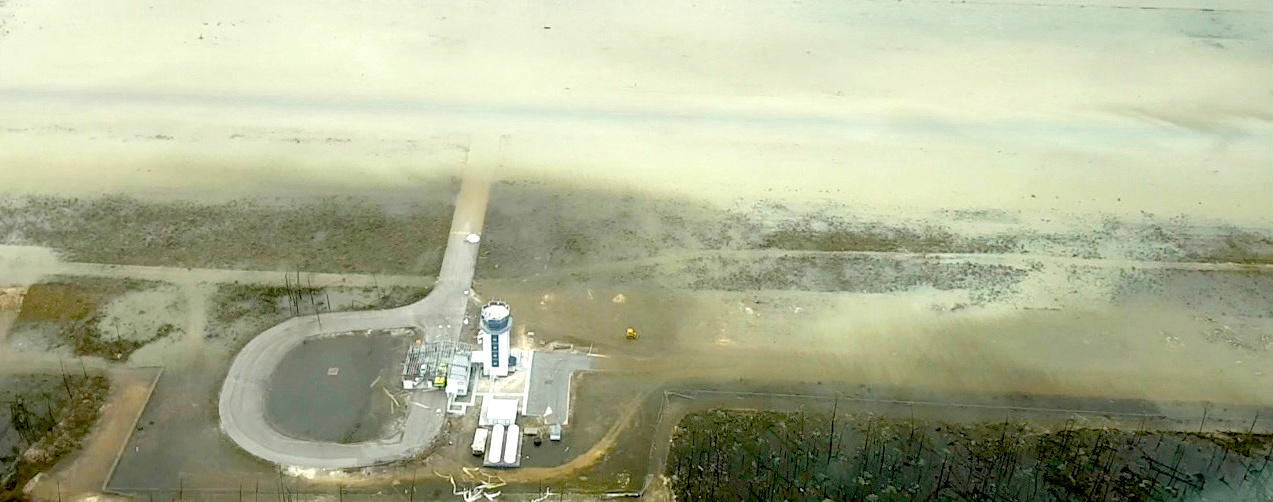
The problem: Is the airport open? We don't know.
It’s not a new issue. A hurricane hits, normal lines of communication get wiped out. No NOTAMs, no weather reports, and nobody to ask – no working emails, no landlines. There is little to go on, if anything.
The silence can be deafening. Scores of operators are ready with aircraft to assist, but without basic information like the below – they can’t go:
- Is the airport open? Is it secure?
- What condition is the runway in? How about the ramp?
- Is there fuel available, and has it been checked for contamination?
- Is there an Air Traffic Control service?
- Are roads to the airport open?
- What cargo offload equipment is available?
Here’s why the information problem exists:
1. The NOTAM system stops working. Even in routine operations, NOTAM’s are not robustly dependable, but it is the primary source of aviation information. After a hurricane, there is a long period – days, not hours – where no NOTAM’s are issued.
2. The next best option is to contact the airport. However, published contact lists for Airport operations, managers and ATC are rarely reliable and usually out of date.
3. Even with the right phone number, email, even AFTN address – the chances of getting a reply immediately post-hurricane are slim. People tend to their families first, and are not likely to be in their office or at the airport in the first few days.
4. Any phone number, email address that is working – and the person answering – is likely to be overloaded and overwhelmed.
3. Rogue pilots, flying dark
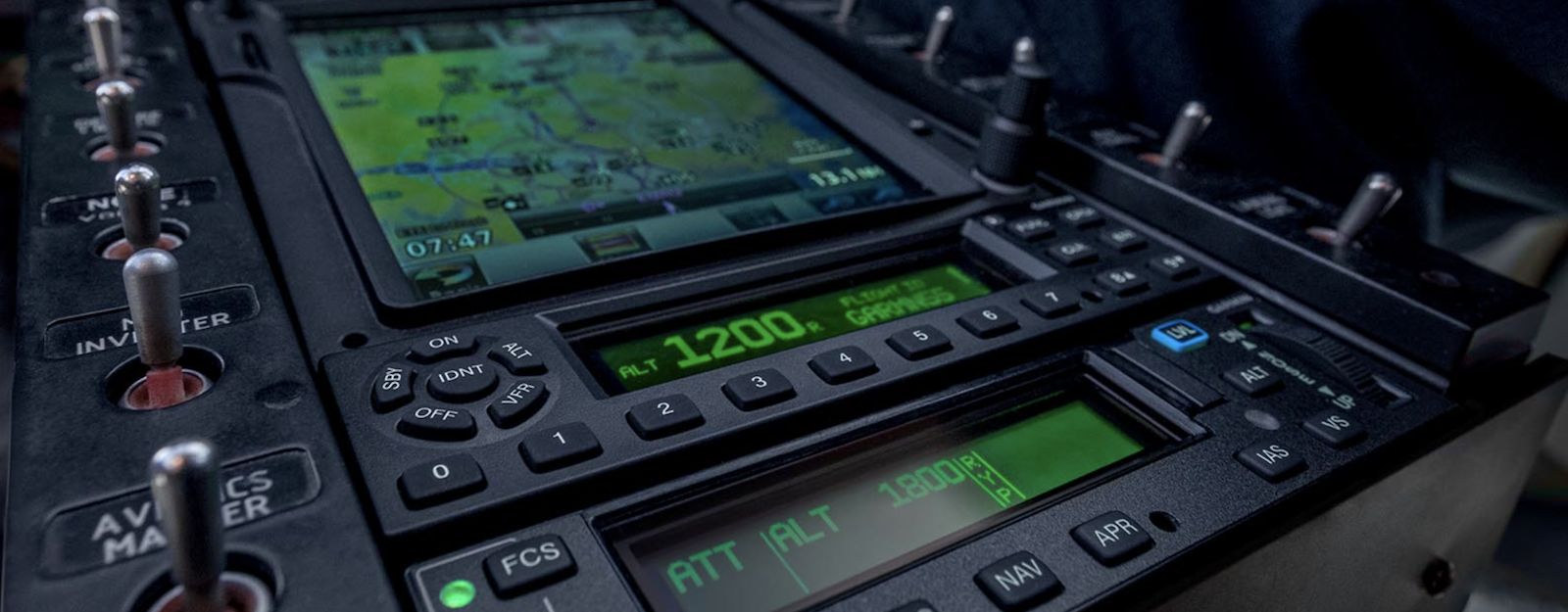
The problem: Pilots hiding their position.
See and be seen. This is the cornerstone of collision avoidance. Even with ATC, we still use lights, anti-collision beacons, transponders, and TCAS to add a layer of safety.
In the Bahamas Airlift, there were many pilots that chose to operate “dark”; deliberately turning off transponders and ADS-B, so that they could not be seen. Primarily, this was because they were unable or unwilling to get approval from NEMA and the CAA to operate in the restricted airspace around the islands.
And so they went anyway, disregarding any concern for fellow aviators, hiding their position, and creating a volatile safety risk.
“Abaco’s … we had another near miss today, when a fixed-wing came flying out of the clouds, transponder off, 100 feet above me . “
Fun fact: TCAS – the failsafe collision preventer – doesn’t work if the other aircraft isn’t squawking.
4. Who has room on a flight for us?
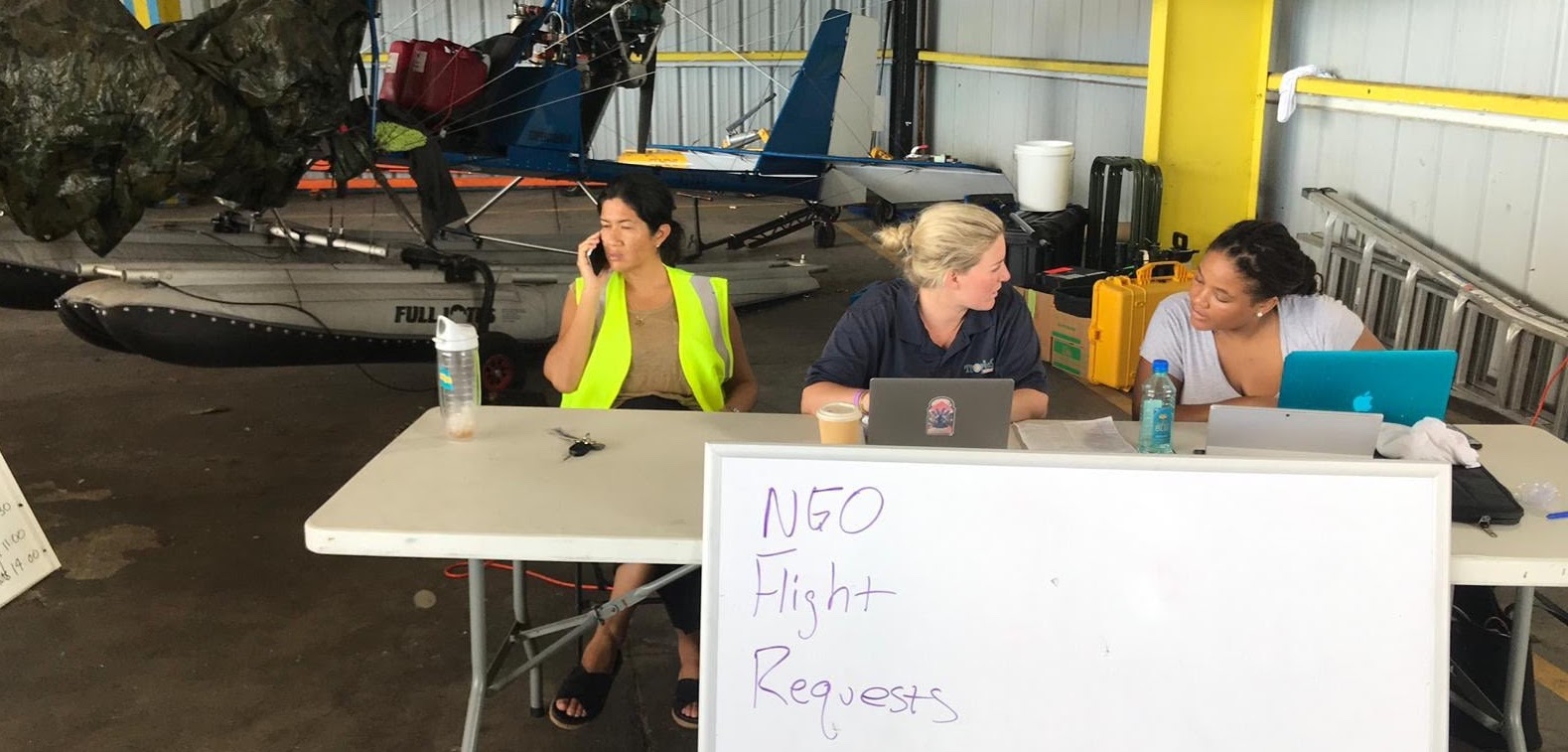
The problem: No Flight Request procedure.
Thanks to the multitude of aircraft and helicopters responding, there was a good amount of spare capacity in the Bahamas. But if your relief organization needs to use that, how?
“… I remember showing up in Nassau to transport six doctors. Two other planes had already come to do the same mission. Many of us were just picking up random people, whoever was ready or dropping random supplies to wherever. A flight board to see what was needed, with a priority ranking would have gotten aid to the most critical in an expedited fashion …”
The picture above shows a Flight Request desk that starting operating in week two. Very simple – come and tell us what you need, and we’ll find a flight for you. It worked well. However, it only happened by chance. The people manning the desk did not belong to a organization – they were locals that volunteered.
Setting up a simple Flight Request system – to connect empty seats and cargo capacity, with those people needing to use it – even just using Google Sheets and a What’s App group, would be immensely helpful.
5. How do we get a permit?
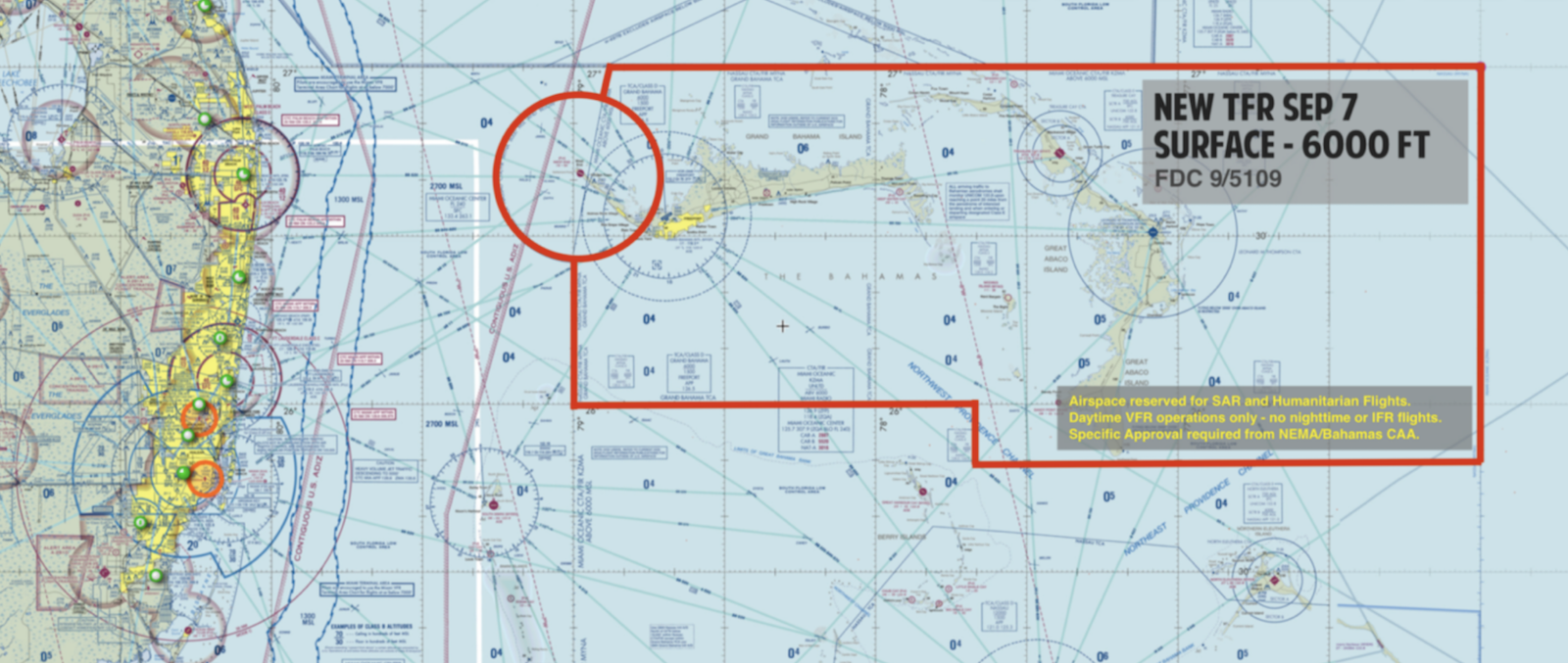
The problem: Getting permission to operate.
There is no doubt that the Bahamas CAA was overwhelmed with the scale of the response. Given the overwhelming General Aviation volume, which formed the largest part of the overall aviation effort in terms of aircraft numbers, it’s understandable that the process to obtain permission to operate would be challenging to manage on the CAA side.
That said, for those that had immediate large-scale relief to offer, the process slowed that relief down. It was not clear nor easy to find out how to get approval, who to contact (email addresses changed often as different people took on the task), what documents to send. For many, there was a silent wait of 24-48 hours, often more, before approval would come.
An online system would be helpful, and a single website address for aircraft approvals that could be pointed to in NOTAM’s, would be ideal.
6. Size matters


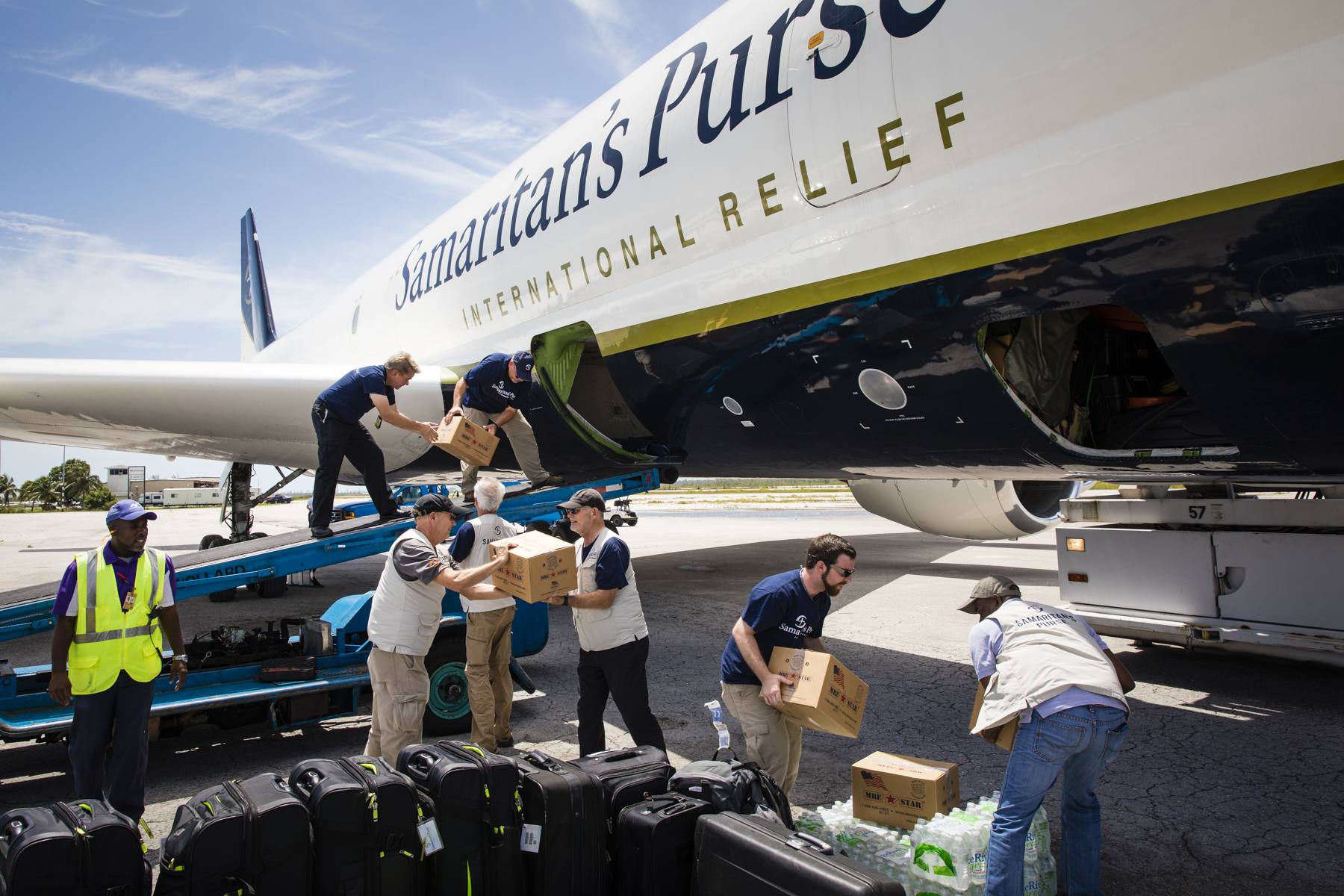
Good
Better
Best
The problem: Too many small aircraft.
If only one thing was crystal clear from Dorian, it was this: airspace is a finite resource. You can only fit so many aircraft into one bit of sky. In routine situations, ATC impose flow rates and capacity constraints to allow them to safely handle a fixed number of aircraft.
Dorian was anything but routine, but it still needed some way to constrain the amount of aircraft wanting to operate. There was no way to do that.
The primary problem was small aircraft. They operate VFR, and there is no easy way for ATC to restrict traffic flow in uncontrolled airspace. Even though approval was required to enter the TFR (restricted airspace around the northern Bahamas), there was no way to determine when those approvals would be used.
As a result, swarms of small aircraft descended on tiny airports, and their presence meant that larger aircraft had to hold, wait, divert, or not fly. Very simply, large amounts of relief could not be delivered, because smaller amounts of relief were getting in the way.
Even with the most professional of crews, there is no way to safely separate aircraft above a certain volume. When this airspace saturation became extreme, which was on Friday, Sept. 6th – the only option we had as an aviation community to get the message out, was by articles and direct emails to groups of pilots. Below are examples of the messaging from AOPA and OPSGROUP.
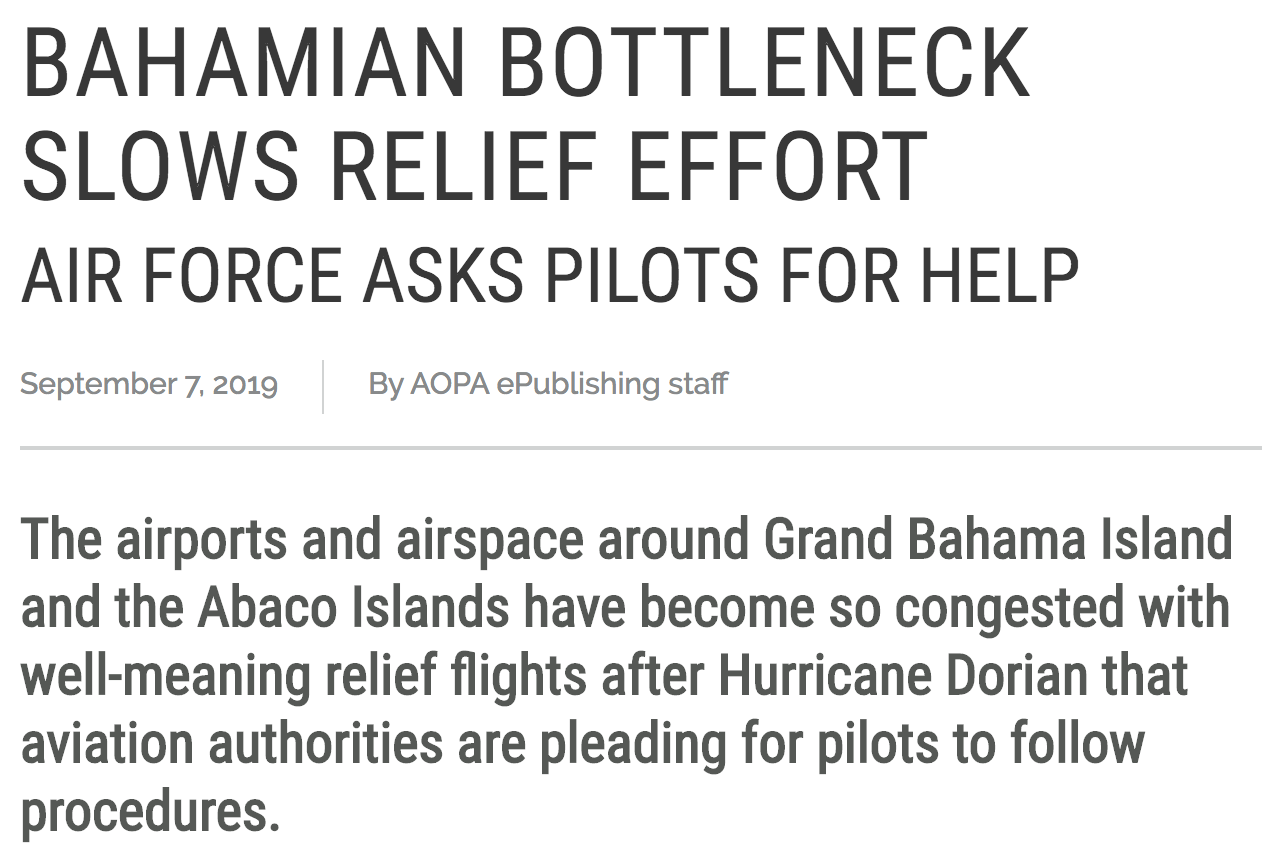
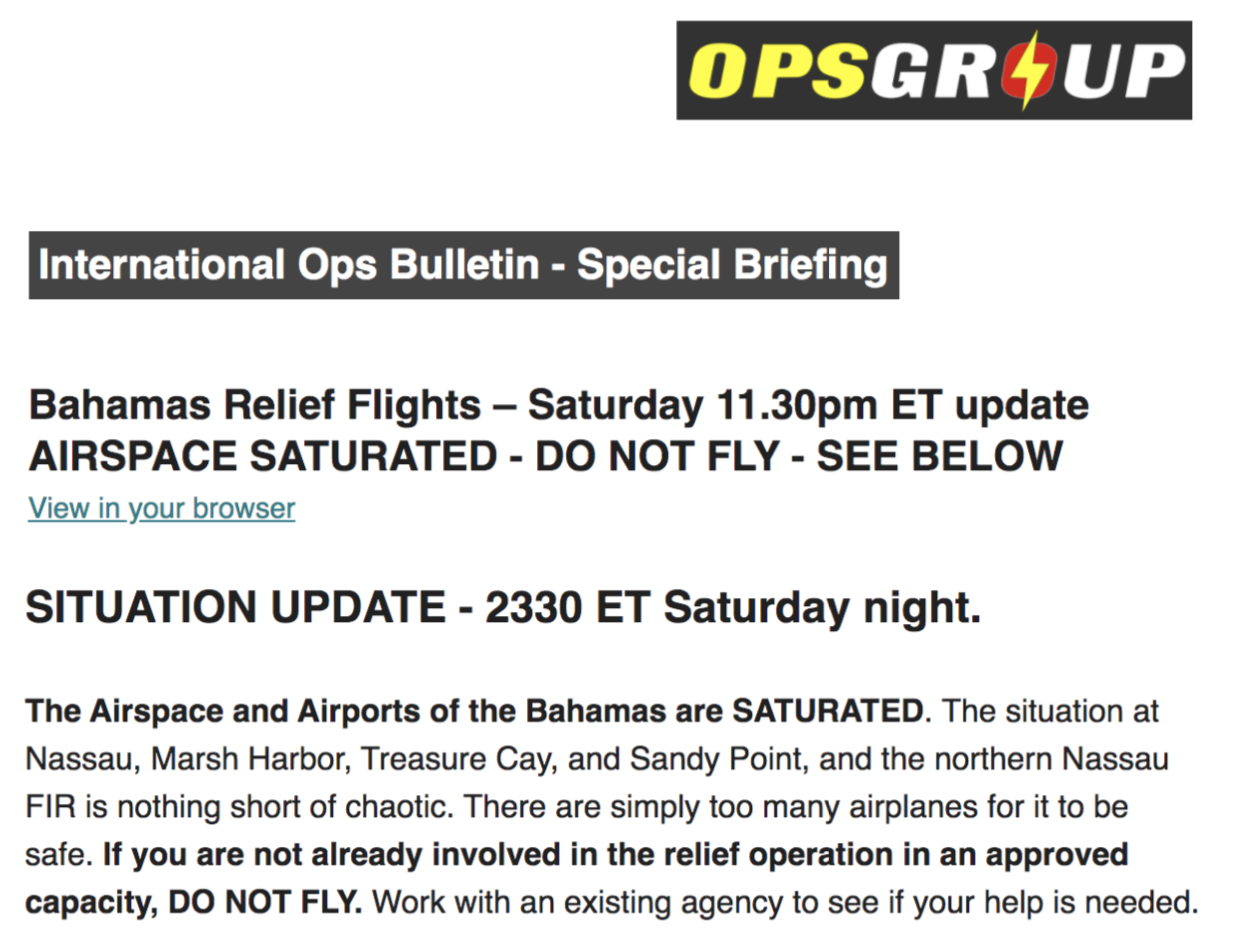
Without doubt, the level of traffic in Dorian was not routine for relief efforts. The proximity of Florida, with one of the highest General Aviation aircraft ownership levels in the world, just 50 miles from the northern Bahamas, was the key to the airspace saturation.
It will never be as big an issue elsewhere in the Caribbean, but even if there are lower volumes of aircraft, the problem remains: We don’t have any way to manage the flow of VFR aircraft responding.
It’s a tough problem to solve. People want to help. General Aviation has an essential role to play. Every person evacuated, every box dropped in, means something life-saving and life-changing for those that are aided. But this is a big picture issue.
If a C-130 is holding 20 miles out waiting for a stream of Pipers and Cessna’s to subside, we’re doing it wrong.
7. We’re not talking to each other
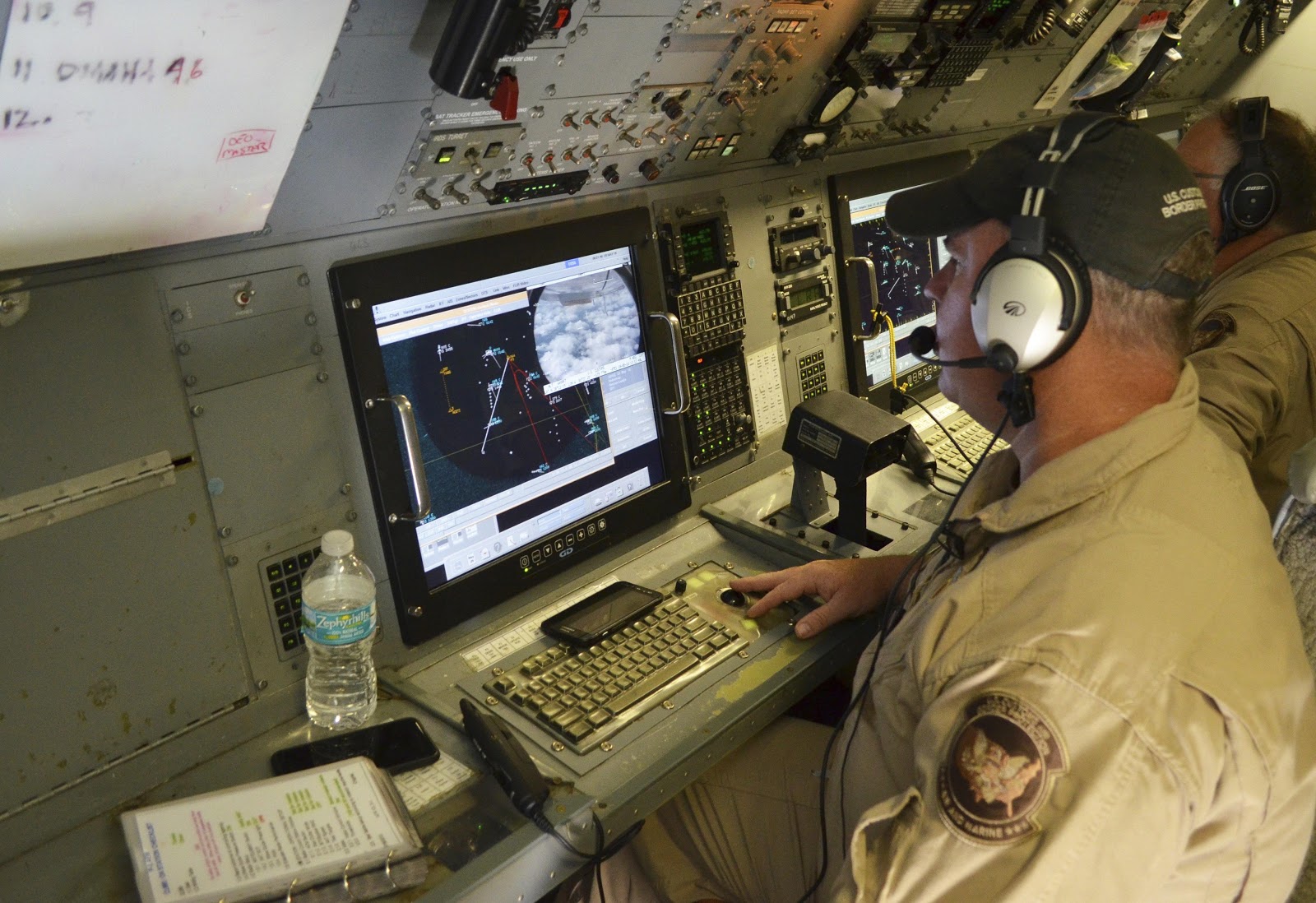
The problem: Many responses, little coordination.
Back to the well-oiled aviation machine that we know and love: routine operations. Hundreds of moving parts, all connected, all flowing, all working. It’s an incredible system. It takes a team of a thousand to get a 787 from one side of the Atlantic to the other. It works. And it works safely.
Little of that exists when it comes to aviation in relief operations. It’s often a chaotic, bureaucratic, dangerous mess. Coupled with that, is a bigger – and more solvable – problem. We’re not talking to each other.
There are too many silos. Air Force. Coast Guard. Air Traffic Control. Relief organizations. Airlines. The UN. Airports. Met offices. Emergency Management Agencies. Private operators.
In Dorian, the USAF 621st Contingency Response Wing was one of the first to respond and assess. The US Coast Guard was immediately on scene. A mysterious “Warlock 48” aircraft circled above. What did they see? What could they share? Given the information problem we talked about above, PIREPS (Pilot Reports) are invaluable. You get real information, from a qualified crew, who can tell you the situation as it’s happening.
There were in excess of two hundred different relief organizations operating in the Bahamas. Many were aviation based. But there was no clear way to communicate with each other. As a result, there was doubling of efforts, and more critically, lack of information to go on to get relief where it mattered.
How do we solve that? The answer sounds simple – we talk to each other more. But we need mechanisms and some basic tools to do that. It can be as simple as What’s App groups and Google Sheets – we don’t need any fancy custom software or conferences. Just something that enables us to connect and work together.
There are always reservations when it comes to sharing information – even in relief, there is competition, secrecy, privacy. But we must remember why we are here – we are here to help the people of this island, this place, to get to safety, to stay alive, to feed their family, to give them hope, comfort, reassurance.
If ever there was a time to work together, and not alone, this is it. When we share basic operational information, everyone benefits.
8. Held at gunpoint
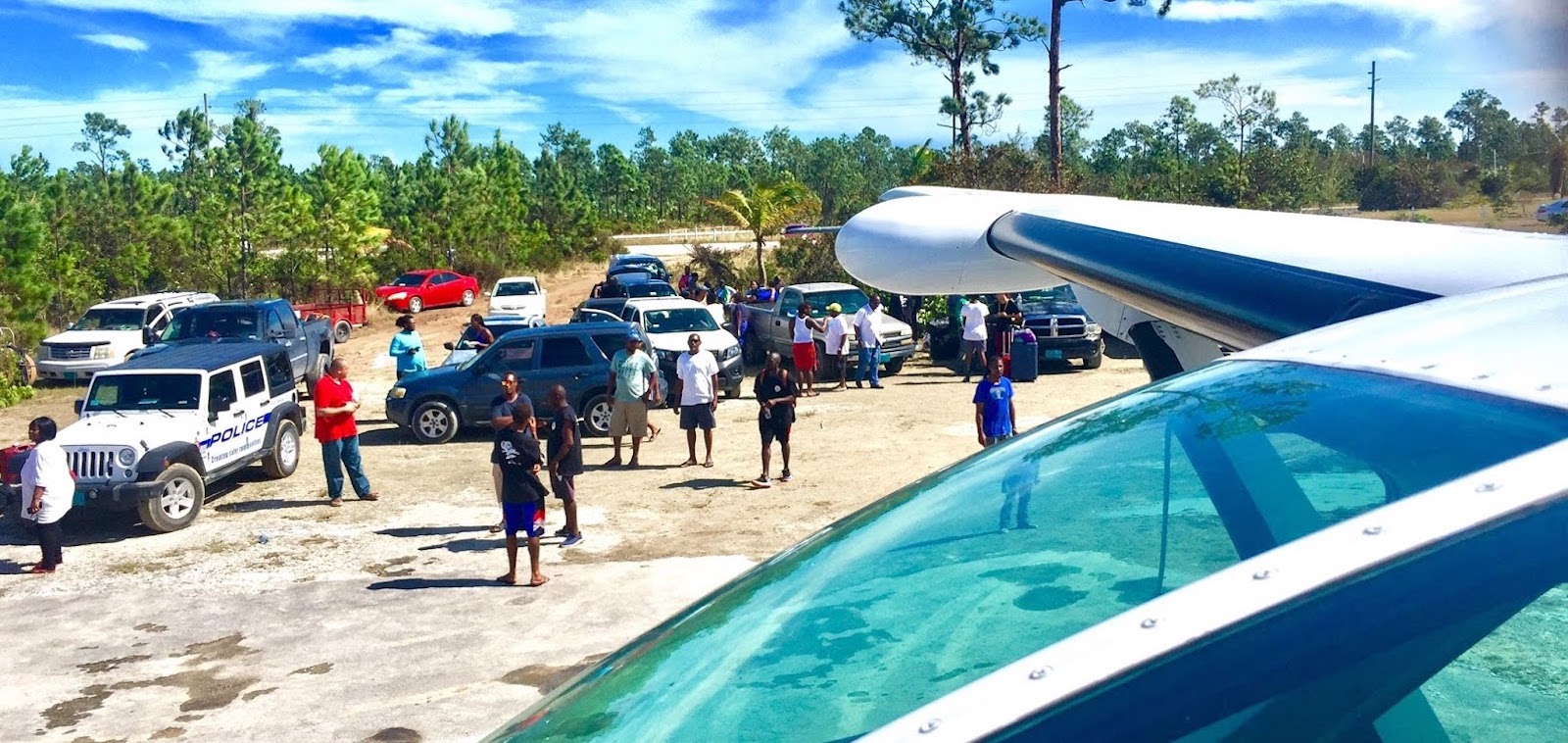
The problem: Airports not secured.
On Day Two of the relief effort, one pilot experienced this:
“… We landed in Treasure Cay and were rushed at by guys with guns. It was very scary. After that we didn’t fly at night or alone. …”
In response, both the Bahamas Defence Force and the Jamaica Defence Force were flown in to secure airport perimeters, but not before word of the incident spread and relief operations were halted. Making airports safe is critical to ensure that relief supplies are able to be distributed, and it’s clear that this must be a first priority in government response.
9. Where would you like us to go?

The problem: We can help, but we don't know where.
Here’s a message typical of those we received after Dorian:
“… We have a Gulfstream 550, crewed, fuelled, and ready to go – free of charge. Where are we needed?”
Through OPSGROUP, and some of the social media groups we created in Dorian, we had a lot of offers of help. Not just one or two – dozens of offers of aircraft, helicopters, pilots, crews.
Matching demand with supply is a challenge, and never more so than in a relief operation. No doubt of that. But what we learned in Dorian, is that in large-scale crises, the emergency management agency becomes overwhelmed, and quickly.
It was frustrating. Understandable, but frustrating. From time to time we were able to regain contact, and get some suggestions on where we could direct the support we had available. Mostly, that didn’t happen, so we had to take our own best guess.
Often, we talked directly to locals on the ground. In one case, we had intermittent What’s App contact with a man in Fox Town. He told us what they needed more than anything was “Diapers, chainsaws, and tarp“. You’d get a curious look at Home Depot with that order, but it was exactly what we needed to hear. The next morning, we were able to get a floatplane to Fox Town to drop off exactly that.
But the problem is that we were only able to help in this way – not through direction from a larger agency that had things under control.
If aviation is to be effective, solid direction from the emergency management agency is critical.
Here’s what people involved said …
When the dust settled, and relief turned to rebuilding, we asked the people that were involved in the early days of Dorian to tell us what they saw, and what they thought could be done better. There is much to learn from Dorian, and we want to help aviation play its part better. We’ll round off this article with a snapshot of those comments. If you want to help us, please read about volunteering with us.
Pilot and Aircraft Operator reports:
… It was extraordinarily chaotic. ATC was overwhelmed with the volume and diversity of aircraft and capabilities. The single Unicom covering several hundred miles didn’t help either, pilots were making calls 40 miles out and contesting the frequency with excessive phraseology.
A complete cluster. Utter chaos in the skies. A humanitarian war zone. Confusion, lack of fellow aviators following established rules/procedures. It was simply a mess beyond belief. ATC once departing Miami Center was essentially non-existent. Planes being turned away to Freeport, a gigantic mess with planes holding trying to arrive in Nassau, clearly ATC was ill equipped to handle the traffic flow.
I was landing downwind at Treasure Cay with pilots taking off opposite direction between Hawkers and 172’s. It’s no time for amateur hour. I wish there was a remote tower.
WhatsApp groups worked well and people were responsive. There did not seem to be a repository and snapshot of information though until WFP and OCHA began sitreps.
I was not personally involved, yet I know definitively of a situation in which a Cirrus Vision Jet was attempting to land at Treasure when three planes simultaneously lifted off of the runway the wrong direction for traffic/landing flow and the pilot made an evasive maneuver to avoid the multiple conflicting aircraft. It was as if there were no rules that applied nor common sense nor decency for ensuring the safe operation of other responding aircraft.
The creation of an Aviation stand alone emergency cell would be useful.
Need to establish a quick and easy way for pilots to get Permit numbers ASAP. The flow of information ASAP is also critical.
It was very difficult to determine what the ground conditions were like in Abaco on Sunday. It was pretty much a “go over and take a look” operation. A report about each field’s condition would have been very helpful.
Station experienced ATC controllers on the ground. Even someone with a basic ground station or handheld radio (would like need a stronger output/antenna however). Folks who are used to high volume, chaotic airspace – ie: Oshkosh or Sun ‘n Fun controllers – many of whom are based right in Florida. Secondly, a quick, easy-to-read airport status report, perhaps sent on a distribution list or posted online. Status, runway condition, security, etc.
Hands down OpsGroup was the shining star of these relief efforts. The organization provided invaluable insight, real-time data and coordination amongst countless participants in the relief efforts. I can not state strong enough what a huge effect OpsGroup had on the successful outcome of these relief efforts. On the relief group side, AEROBridge stepped up in a huge way while other organizations bowed out. I don’t fault the others, they made operational decisions based upon safety which is always to be commended. Yet AEROBridge looked the challenge in the eye and executed consistently stepping up to the challenge to deliver incredible results which made an impact.
Too may “do gooders” on individual missions/flights saturated the airspace overwhelming the airports. Also, according the USCG, low level flyers interrupting the rescue work of the USCG helicopters.
TFR process and requirements slowed the initial response. Towers not working. External assistance (ie USAF) should have been invited in day 1. Then once the airspace was being managed, customs bureaucracy on the ground became problematic. Also ground handling and ramp management at Freeport could have been better – perhaps external assistance could have helped.

